Deck 3: Laws of Motion
Question
Question
Question
Question
Question
Question
Question
Question
Question
Question
Question
Question
Question
Question
Question
Question
Question
Question
Question
Question
Question
Question
Question
Question
Question
Question
Question
Question
Question
Question
Question
Question
Question
Question
Question
Question
Question
Question
Question
Question
Question
Question
Question
Question
Question
Question
Question
Question
Question
Question
Question
Question
Question
Question
Question
Question
Question
Question
Question

Unlock Deck
Sign up to unlock the cards in this deck!
Unlock Deck
Unlock Deck
1/59
Play
Full screen (f)
Deck 3: Laws of Motion
1
Which of the following is true about a comet that is on an elliptical orbit around the Sun?
A) The comet's speed is greatest when it is farthest from the Sun.
B) The comet's speed is greatest when it is nearest the Sun.
C) This comet's speed is zero.
D) The comet's speed is constant because its mass and the Sun's mass stay approximately the same.
A) The comet's speed is greatest when it is farthest from the Sun.
B) The comet's speed is greatest when it is nearest the Sun.
C) This comet's speed is zero.
D) The comet's speed is constant because its mass and the Sun's mass stay approximately the same.
The comet's speed is greatest when it is nearest the Sun.
2
The centrifugal force experienced by a body in circular motion is a reaction to:
A) the force of gravity.
B) the body's weight.
C) the force that causes the motion to be circular.
D) the contact forces between the molecules of the material.
A) the force of gravity.
B) the body's weight.
C) the force that causes the motion to be circular.
D) the contact forces between the molecules of the material.
the force that causes the motion to be circular.
3
How are mass and inertia related?
A) More massive objects contain more Inertia.
B) Less massive objects contain more inertia.
C) Inertia and mass are unrelated.
D) Only masses in motion contain intertia.
A) More massive objects contain more Inertia.
B) Less massive objects contain more inertia.
C) Inertia and mass are unrelated.
D) Only masses in motion contain intertia.
More massive objects contain more Inertia.
4
If the distance between Earth and the Sun were cut in half,the gravitational force between these two objects would:
A) decrease by 4.
B) decrease by 2.
C) increase by 2.
D) increase by 4.
A) decrease by 4.
B) decrease by 2.
C) increase by 2.
D) increase by 4.

Unlock Deck
Unlock for access to all 59 flashcards in this deck.
Unlock Deck
k this deck
5
In the figure below,if the acceleration of the container is 2 m/s²,with what force did the woman push? 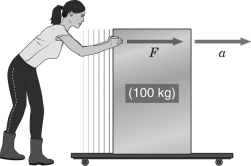
A) 50 N
B) 100 N
C) 150 N
D) 200 N

A) 50 N
B) 100 N
C) 150 N
D) 200 N

Unlock Deck
Unlock for access to all 59 flashcards in this deck.
Unlock Deck
k this deck
6
In which of the following situations would the object be experiencing an unbalanced force?
A) a truck at rest
B) a car moving at constant speed turning a corner
C) a rocket moving at a constant speed straight up away from Earth
D) a car moving at a constant speed toward the right
A) a truck at rest
B) a car moving at constant speed turning a corner
C) a rocket moving at a constant speed straight up away from Earth
D) a car moving at a constant speed toward the right

Unlock Deck
Unlock for access to all 59 flashcards in this deck.
Unlock Deck
k this deck
7
Which of Newton's laws states that if an unbalanced force acts on an object,then the object's motion changes?
A) Newton's first law
B) Newton's second law
C) Newton's third law
D) Newton's law of gravitation
A) Newton's first law
B) Newton's second law
C) Newton's third law
D) Newton's law of gravitation

Unlock Deck
Unlock for access to all 59 flashcards in this deck.
Unlock Deck
k this deck
8
Which scientist ended up under house arrest because of his support of the heliocentric model?
A) Galileo Galilei
B) Isaac Newton
C) Johannes Kepler
D) Tycho Brahe
A) Galileo Galilei
B) Isaac Newton
C) Johannes Kepler
D) Tycho Brahe

Unlock Deck
Unlock for access to all 59 flashcards in this deck.
Unlock Deck
k this deck
9
The natural tendency of an object to resist changes in motion is called:
A) inertia.
B) weight.
C) acceleration.
D) mass.
A) inertia.
B) weight.
C) acceleration.
D) mass.

Unlock Deck
Unlock for access to all 59 flashcards in this deck.
Unlock Deck
k this deck
10
In the figure below,if the woman pushes with a force of 50 N,what will be the acceleration of the container? 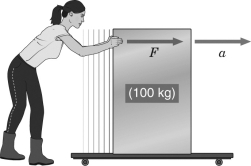
A) 0.5 m/s2
B) 0.75 m/s2
C) 1 m/s2
D) 2 m/s2

A) 0.5 m/s2
B) 0.75 m/s2
C) 1 m/s2
D) 2 m/s2

Unlock Deck
Unlock for access to all 59 flashcards in this deck.
Unlock Deck
k this deck
11
Which observations made by Galileo are inconsistent with the geocentric model of astronomy?
A) craters on the Moon
B) orbits of Jupiter's moons and phases of Venus
C) retrograde motion of Mars
D) sunspots
A) craters on the Moon
B) orbits of Jupiter's moons and phases of Venus
C) retrograde motion of Mars
D) sunspots

Unlock Deck
Unlock for access to all 59 flashcards in this deck.
Unlock Deck
k this deck
12
What do the Copernican and Ptolemaic models have in common?
A) elliptical orbits
B) Sun as center of the universe
C) circular orbits
D) Earth as center of universe
A) elliptical orbits
B) Sun as center of the universe
C) circular orbits
D) Earth as center of universe

Unlock Deck
Unlock for access to all 59 flashcards in this deck.
Unlock Deck
k this deck
13
If an object is moving in a circular orbit at a constant speed,which of the following is FALSE?
A) Its acceleration is not zero.
B) Its acceleration is zero.
C) Its velocity is not zero.
D) There is an unbalanced force acting on it.
A) Its acceleration is not zero.
B) Its acceleration is zero.
C) Its velocity is not zero.
D) There is an unbalanced force acting on it.

Unlock Deck
Unlock for access to all 59 flashcards in this deck.
Unlock Deck
k this deck
14
An empirical science is one that is based on:
A) assumptions.
B) calculus.
C) computer models.
D) observed data.
A) assumptions.
B) calculus.
C) computer models.
D) observed data.

Unlock Deck
Unlock for access to all 59 flashcards in this deck.
Unlock Deck
k this deck
15
Newton's first law states that objects in motion:
A) eventually come to rest.
B) experience an unbalanced force.
C) experience a nonzero acceleration.
D) stay in motion unless acted upon by an external force.
A) eventually come to rest.
B) experience an unbalanced force.
C) experience a nonzero acceleration.
D) stay in motion unless acted upon by an external force.

Unlock Deck
Unlock for access to all 59 flashcards in this deck.
Unlock Deck
k this deck
16
If a 100-kg astronaut pushes on a 5,000-kg satellite and the satellite experiences an acceleration of 0.1 m/s²,what is the acceleration experienced by the astronaut in the opposite direction?
A) 5 m/s2
B) 10 m/s2
C) 50 m/s2
D) 0.1 m/s2
A) 5 m/s2
B) 10 m/s2
C) 50 m/s2
D) 0.1 m/s2

Unlock Deck
Unlock for access to all 59 flashcards in this deck.
Unlock Deck
k this deck
17
In a spaceship orbiting Earth,two astronauts want to measure the mass of a mouse.How can they easily do it if they are in constant free fall?
A) Place the mouse on a spring-loaded scale and weigh it.
B) Measure the gravitational attraction between the mouse and a steel ball of known mass.
C) Drop the mouse from the top of the spaceship to its bottom.
D) Push on the mouse with a known force and measure its acceleration.
A) Place the mouse on a spring-loaded scale and weigh it.
B) Measure the gravitational attraction between the mouse and a steel ball of known mass.
C) Drop the mouse from the top of the spaceship to its bottom.
D) Push on the mouse with a known force and measure its acceleration.

Unlock Deck
Unlock for access to all 59 flashcards in this deck.
Unlock Deck
k this deck
18
Which of the following did NOT require the use of a telescope to observe?
A) spots on the Sun
B) retrograde motion of the planets
C) phases of Venus
D) Jupiter's moons
A) spots on the Sun
B) retrograde motion of the planets
C) phases of Venus
D) Jupiter's moons

Unlock Deck
Unlock for access to all 59 flashcards in this deck.
Unlock Deck
k this deck
19
What is your acceleration if you go from 0 to 60 mph in 4 seconds?
A) 60 mph/s
B) 30 mph/s
C) 15 mph/s
D) 8.5 mph/s
A) 60 mph/s
B) 30 mph/s
C) 15 mph/s
D) 8.5 mph/s

Unlock Deck
Unlock for access to all 59 flashcards in this deck.
Unlock Deck
k this deck
20
You apply a force of 10 N to a grocery cart in order to get an acceleration of 0.5 m/s².If you apply a force of 20 N to the same grocery cart,its acceleration will be:
A) 10 m/s2.
B) 1 m/s2.
C) 0.5 m/s2.
D) 0.25 m/s2.
A) 10 m/s2.
B) 1 m/s2.
C) 0.5 m/s2.
D) 0.25 m/s2.

Unlock Deck
Unlock for access to all 59 flashcards in this deck.
Unlock Deck
k this deck
21
What force holds planets in their orbits?
A) air resistance
B) friction
C) electromagnetic
D) gravity
A) air resistance
B) friction
C) electromagnetic
D) gravity

Unlock Deck
Unlock for access to all 59 flashcards in this deck.
Unlock Deck
k this deck
22
In the figure below,the force of gravity is drawn in the picture.This represents Earth's gravity pulling down on the man.According to Newton's third law,what is the other half of this pair of forces? 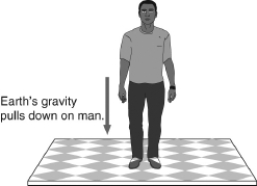
A) the floor pushing up on the man
B) the man pushing on the floor
C) the man's gravity pulling up on Earth
D) the floor pushing backward on the man

A) the floor pushing up on the man
B) the man pushing on the floor
C) the man's gravity pulling up on Earth
D) the floor pushing backward on the man

Unlock Deck
Unlock for access to all 59 flashcards in this deck.
Unlock Deck
k this deck
23
How much would the force of gravity at the surface of the Earth differ if Earth's volume were increased 125 times while its mass was increased 25 times?
A) 25 times less
B) no difference
C) 25 times larger
D) 125 times less
A) 25 times less
B) no difference
C) 25 times larger
D) 125 times less

Unlock Deck
Unlock for access to all 59 flashcards in this deck.
Unlock Deck
k this deck
24
How much would the force of Earth's gravity at its surface differ if the Earth's volume were increased 125 times while its mass was increased 25 times?
A) 25 times less
B) 25 times larger
C) no difference
D) 125 times less
A) 25 times less
B) 25 times larger
C) no difference
D) 125 times less

Unlock Deck
Unlock for access to all 59 flashcards in this deck.
Unlock Deck
k this deck
25
Once a satellite's velocity at closest approach equals or exceeds the ________ velocity,it is in an unbound orbit.
A) tangential
B) linear
C) circular
D) escape
A) tangential
B) linear
C) circular
D) escape

Unlock Deck
Unlock for access to all 59 flashcards in this deck.
Unlock Deck
k this deck
26
Suppose you are suddenly transported to a planet with one-fourth the mass of Earth but the same radius as Earth.Your weight would ________ by a factor of ________.
A) increase; 4
B) increase; 16
C) decrease; 4
D) decrease; 16
A) increase; 4
B) increase; 16
C) decrease; 4
D) decrease; 16

Unlock Deck
Unlock for access to all 59 flashcards in this deck.
Unlock Deck
k this deck
27
List at least three discoveries Galileo made by making astronomical observations through a telescope.

Unlock Deck
Unlock for access to all 59 flashcards in this deck.
Unlock Deck
k this deck
28
Suppose you are suddenly transported to a planet with one-fourth the radius of Earth but the same mass as Earth.Your weight would ________ by a factor of ________.
A) increase; 4
B) increase; 16
C) decrease; 4
D) decrease; 16
A) increase; 4
B) increase; 16
C) decrease; 4
D) decrease; 16

Unlock Deck
Unlock for access to all 59 flashcards in this deck.
Unlock Deck
k this deck
29
Two rocks (call them S and T)are a distance of 50 km from one another.Rock S has 20 times the mass of rock T.Which rock will move faster if the only force involved is their mutual gravitational attraction?
A) rock S
B) Both rocks will move at the same speed.
C) rock T
D) Not enough information is available to answer.
A) rock S
B) Both rocks will move at the same speed.
C) rock T
D) Not enough information is available to answer.

Unlock Deck
Unlock for access to all 59 flashcards in this deck.
Unlock Deck
k this deck
30
What two pieces of information do we need to know about Earth in order to calculate the mass of the Sun?
A) The semimajor axis of Earth's orbit and the mass of Earth.
B) The semimajor axis of Earth's orbit and Earth's orbital period.
C) The radius of Earth and Earth's orbital period.
D) The radius of Earth and the mass of Earth.
A) The semimajor axis of Earth's orbit and the mass of Earth.
B) The semimajor axis of Earth's orbit and Earth's orbital period.
C) The radius of Earth and Earth's orbital period.
D) The radius of Earth and the mass of Earth.

Unlock Deck
Unlock for access to all 59 flashcards in this deck.
Unlock Deck
k this deck
31
The force of gravity between Earth and the Sun is ________ the force of gravity between Earth and the Moon.For reference,the average distance between Earth and the Moon is 0.003 AU,the mass of the Moon is 7 × 10²² kg,and the mass of the Sun is 2 × 10³⁰ kg.
A) 86,000 times larger than
B) 260 times larger than
C) 140 times smaller than
D) 6,400 times smaller than
A) 86,000 times larger than
B) 260 times larger than
C) 140 times smaller than
D) 6,400 times smaller than

Unlock Deck
Unlock for access to all 59 flashcards in this deck.
Unlock Deck
k this deck
32
What type of orbit results when a satellite has a velocity greater than the escape velocity?
A) unbound
B) bound
C) circular
D) linear
A) unbound
B) bound
C) circular
D) linear

Unlock Deck
Unlock for access to all 59 flashcards in this deck.
Unlock Deck
k this deck
33
Your weight is directly proportional to your:
A) height.
B) age.
C) mass.
D) altitude.
A) height.
B) age.
C) mass.
D) altitude.

Unlock Deck
Unlock for access to all 59 flashcards in this deck.
Unlock Deck
k this deck
34
Astronauts orbiting Earth in a spacecraft feel weightless in space because:
A) they are farther away from Earth.
B) they eat less food while in orbit.
C) the added gravitational pull of the Moon balances Earth's gravitational pull.
D) they are in constant free fall around Earth.
A) they are farther away from Earth.
B) they eat less food while in orbit.
C) the added gravitational pull of the Moon balances Earth's gravitational pull.
D) they are in constant free fall around Earth.

Unlock Deck
Unlock for access to all 59 flashcards in this deck.
Unlock Deck
k this deck
35
If your weight on Earth was 500 N,what would your weight be on the Moon?
A) 83 N
B) 125 N
C) 250 N
D) 500 N
A) 83 N
B) 125 N
C) 250 N
D) 500 N

Unlock Deck
Unlock for access to all 59 flashcards in this deck.
Unlock Deck
k this deck
36
The force of gravity that an object has is directly related to its:
A) inertia.
B) size.
C) mass.
D) density.
A) inertia.
B) size.
C) mass.
D) density.

Unlock Deck
Unlock for access to all 59 flashcards in this deck.
Unlock Deck
k this deck
37
In the absence of air friction,a 0.001-kg piece of paper and a 0.1-kg notebook are dropped from the same height and allowed to fall to the ground.How do their accelerations compare?
A) The accelerations are the same.
B) The notebook's acceleration is 100 times faster than the paper's acceleration.
C) The notebook's acceleration is 1,000 times faster than the paper's acceleration.
D) The paper's acceleration is 100 times faster than the notebook's acceleration.
A) The accelerations are the same.
B) The notebook's acceleration is 100 times faster than the paper's acceleration.
C) The notebook's acceleration is 1,000 times faster than the paper's acceleration.
D) The paper's acceleration is 100 times faster than the notebook's acceleration.

Unlock Deck
Unlock for access to all 59 flashcards in this deck.
Unlock Deck
k this deck
38
If you weighed 150 lb on Earth,what would you weigh on Mars? For reference,Mars has a mass that is 0.1 times Earth's mass,and Mars has a radius that is 0.5 times Earth's radius.
A) 30 lb
B) 110 lb
C) 76 lb
D) 60 lb
A) 30 lb
B) 110 lb
C) 76 lb
D) 60 lb

Unlock Deck
Unlock for access to all 59 flashcards in this deck.
Unlock Deck
k this deck
39
Which of the following properties of an astronaut changes when he or she is standing on the Moon,relative to when the astronaut is standing on Earth?
A) weight
B) mass
C) inertia
D) all of the above
A) weight
B) mass
C) inertia
D) all of the above

Unlock Deck
Unlock for access to all 59 flashcards in this deck.
Unlock Deck
k this deck
40
What is the weight of a 100 kg mass on the moon?
A) 9.8 Newtons
B) 980 Newtons
C) 100 Newtons
D) 163 Newtons
A) 9.8 Newtons
B) 980 Newtons
C) 100 Newtons
D) 163 Newtons

Unlock Deck
Unlock for access to all 59 flashcards in this deck.
Unlock Deck
k this deck
41
How much stronger is the gravitational force of the Sun on Earth compared to the gravitational force of the Sun on Pluto? Note that Pluto's semimajor axis is 40 AU,and its mass is 0.002 times the mass of Earth.

Unlock Deck
Unlock for access to all 59 flashcards in this deck.
Unlock Deck
k this deck
42
An analogy of orbital motion is the twirling of a ball connected by a string.What is the action-reaction force pair described by Newton's third law?

Unlock Deck
Unlock for access to all 59 flashcards in this deck.
Unlock Deck
k this deck
43
What is required to change an object's motion?

Unlock Deck
Unlock for access to all 59 flashcards in this deck.
Unlock Deck
k this deck
44
Examine the figure below.If the acceleration of the container is 2 m/s²,with what force did the woman push?
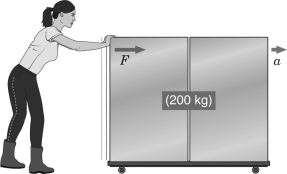


Unlock Deck
Unlock for access to all 59 flashcards in this deck.
Unlock Deck
k this deck
45
The figure below shows Newton's cannonball thought experiment.At the three locations of the cannonball shown,draw and label arrows representing the circular velocity and acceleration.
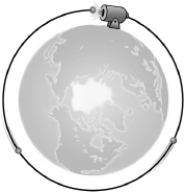


Unlock Deck
Unlock for access to all 59 flashcards in this deck.
Unlock Deck
k this deck
46
Name the two ways in which an object's motion (meaning its velocity)can experience a nonzero acceleration.

Unlock Deck
Unlock for access to all 59 flashcards in this deck.
Unlock Deck
k this deck
47
What acceleration would result from a 5-N force acting on a 3-kg object? (A Newton [N] has units of kg m/s².)

Unlock Deck
Unlock for access to all 59 flashcards in this deck.
Unlock Deck
k this deck
48
Explain the difference between being weightless and being in free fall.

Unlock Deck
Unlock for access to all 59 flashcards in this deck.
Unlock Deck
k this deck
49
Is there a difference in your weight between when you are on top of a mountain at 1,000 meters above sea level compared to when you are sitting in a classroom at 10 meters above sea level?

Unlock Deck
Unlock for access to all 59 flashcards in this deck.
Unlock Deck
k this deck
50
An object in a circular orbit is in a perpetual state of free fall,i.e.,accelerating toward Earth but never reaching it.Explain.

Unlock Deck
Unlock for access to all 59 flashcards in this deck.
Unlock Deck
k this deck
51
In a period of 3 months,a planet travels 30,000 km with an average speed of 10.5 km/s.Some time later,the same planet travels 65,000 km in 3 months.How fast is the planet traveling at this later time? During which period is the planet closer to the Sun?

Unlock Deck
Unlock for access to all 59 flashcards in this deck.
Unlock Deck
k this deck
52
What information would you need to obtain about one of the moons of the planet Jupiter in order to measure the mass of Jupiter?

Unlock Deck
Unlock for access to all 59 flashcards in this deck.
Unlock Deck
k this deck
53
If a 100-kg asteroid collides with Earth,causing the asteroid to decelerate in 1 second from 1,000 m/s to 0 m/s,what acceleration will Earth experience according to Newton's third law? (Earth has a mass of approximately 6 × 10²⁴ kg.)

Unlock Deck
Unlock for access to all 59 flashcards in this deck.
Unlock Deck
k this deck
54
Examine the figure below.If the woman pushes with a force of 200 N,what is the acceleration of the container?
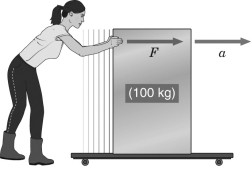


Unlock Deck
Unlock for access to all 59 flashcards in this deck.
Unlock Deck
k this deck
55
If every action of a force is met by an equal but opposite force,why does anything accelerate?

Unlock Deck
Unlock for access to all 59 flashcards in this deck.
Unlock Deck
k this deck
56
Astronauts feel "weightless" on the Moon.Using Newton's universal law of gravitation,explain why astronauts experience this feeling.

Unlock Deck
Unlock for access to all 59 flashcards in this deck.
Unlock Deck
k this deck
57
According to Newton's third law,forces come in pairs.Two forces in the figure below are labeled.Label the other half of the pairs.
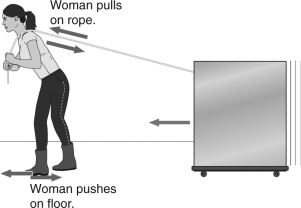


Unlock Deck
Unlock for access to all 59 flashcards in this deck.
Unlock Deck
k this deck
58
Given a constant acceleration from rest,how is the increase in speed computed?

Unlock Deck
Unlock for access to all 59 flashcards in this deck.
Unlock Deck
k this deck
59
In the figure below,draw an arrow representing the direction of the acceleration in each case.If the acceleration is zero,write zero.
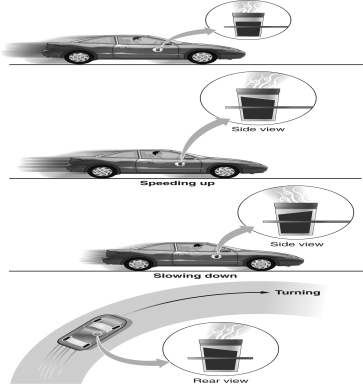


Unlock Deck
Unlock for access to all 59 flashcards in this deck.
Unlock Deck
k this deck



